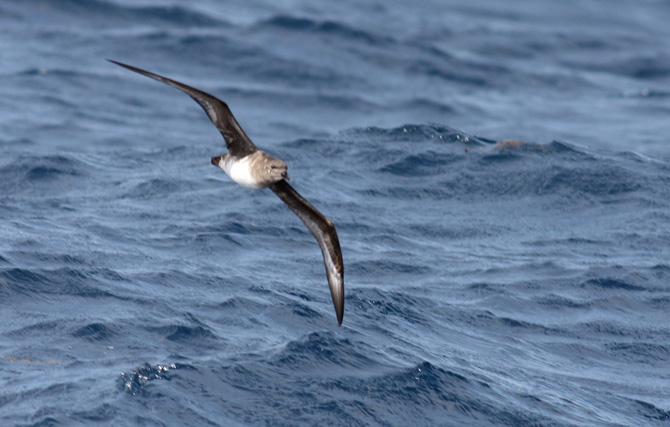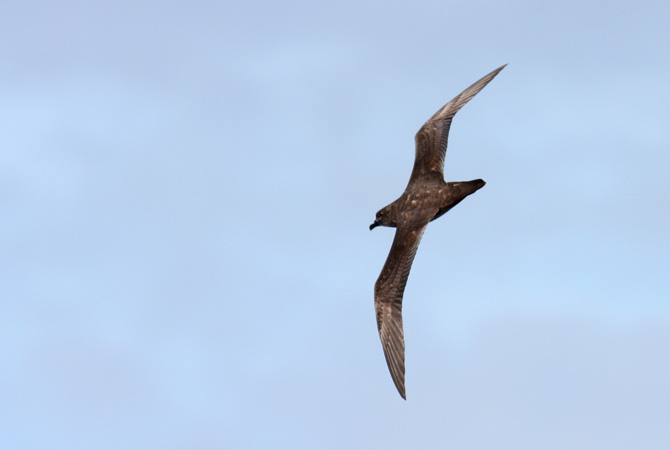
Seabird Report- Recent Photos and Highlights
December 27
We ran a trip the same day as the Cape Hatteras Christmas Bird Count, and it was a tough day, complete with wind, rain, and pea soup fog (fortunately not all at the same time.) There was a plague of warm water south of the Cape and a brisk southeaster, so all we could really do was to go to the Gulf Stream, where we found Black-capped Petrels in modest numbers, a few gulls, a Pomarine Jaeger, and a Manx Shearwater. Closer to shore, a Sooty Shearwater came to the boat to feed on our chum, and we successfully coaxed it over two miles inshore until it was in the CBC circle. Not surprisingly, it was a first record for the count. Had the weather been a little nicer and less foggy nearshore, I would have crossed Diamond Shoals and gone north to get in some cooler water, but it did not seem prudent given the conditions. We have seen Black-capped Petrel on every trip to the deepwater Gulf Stream from Hatteras, 12 months out of the year now, and it is always great to show them to first time visitors here.
December 6
It was a beautiful day, but not very birdy. This pelagic
trip from Hatteras on Saturday turned out to be more like a
fall trip than a winter trip in regard to bird life seen. I don't have the
totals at hand, but I think we saw maybe 10 Black-capped Petrels, 3 Audubon's
Shearwaters, 3 Wilson's Storm-Petrels, four Red Phalaropes (really close), and
one dark morph Pomarine Jaeger. There was a big area of warm water (72
degrees) from just a few miles off the beach out to 1000 fathoms, but there was
very little current, even 27 miles off Cape Point, where we turned around.
I was hoping there would be a decent current edge and color change, but the
water was warm up onto
Diamond Shoals. We saw the phalaropes where the water cooled off to
62 and turned dirty. There was also an 18 foot long Basking Shark just
inshore of that change, and we watched it swim right under our drifting boat.
Out in the blue water, we also saw some Bottlenose Dolphins, Pilot Whales and
two species of beaked whales. There were good numbers of gannets close to
the beach as well as a few gulls, including some Lesser Black-backs, now a
common species here.
September 21, 2008
This was our first trip here in almost a month! After three days of very brisk northeasterly winds we had a little bit of a break in the weather and we made it out to the Gulf Stream, which we found in about 100 fathoms today. There was a good variety of birds, and we ended up with ten species of pelagic seabirds for the day, in addition to the young Laughing Gulls and Herring Gulls which followed us for miles. Gulls are a rare sight offshore on summer trips here, so this is a sign of the changing seasons. We had fantastic looks at Black-capped Petrels today over the chum slick, but the highlight for most had to be the light morph Trindade Petrel we saw in about 200 fathoms. It made several close passes, such that binoculars were not necessary for identification. I forgot to bring my camera, but Bob Fogg shared a couple of nice photos for the website. Do not use without permission.
Trip participant and sometimes leader Jeff Pippen of Durham, NC also got a series of great photos (w/ a 100mm lens!!!) which are posted here- http://www.duke.edu/~jspippen/birds/heraldpetrel.htm


August 22 to August 24, 2008
Chris Sloan helped Kate and I lead these trips, and while he was aboard he took several photos, which he has shared with us. These should not be used without permission by the photographer.
.jpg)
Audubon's Shearwaters came in with the Sargasso Weed this weekend. A lack of easterly winds and hurricane swell so far this summer meant there was less Sargassum than usual in the Gulf Stream here this July and early August. These small shearwaters feed extensively under patches of this brown algae, and if it is scarce or scattered, so are they.
.jpg)
Some of the Audubon's Shearwaters were undergoing molt.
%20in%20Gulf%20Stream%20off%20Hatteras,%20NC%20(2008-08-24).jpg)
But there were some fresh juveniles around though, which is always good to see.
.jpg)
Deep water birding was comparatively slow, but we did have a rather obliging Band-rumped Storm-Petrel on August 24. This species is seldom seen here after August.
%20in%20Gulf%20Stream%20off%20Hatteras,%20NC%20(2008-08-23).jpg)
This Masked Booby, seen on the August 23 trip, was our third this year off Hatteras. It was feeding over Skipjack Tuna with a large number of shearwaters.
.jpg)
We were able to get within spitting distance of these Red-necked Phalaropes. The bird to the left is a juvenile while the right hand bird is a molting adult.
%20%20in%20Gulf%20Stream%20off%20Hatteras,%20NC%20(2008-08-24).jpg)
Sooty Terns were seen in good numbers each day, but on August 24 we found them feeding over dolphin (mahi mahi) in nice morning light.
.jpg)
We also found good numbers of Bridled Terns this day, including adults.
%20in%20Gulf%20Stream%20off%20Hatteras,%20NC%20(2008-08-24).jpg)
Some of the adult Bridled Terns were accompanied by crisply plumaged, begging juveniles, and one one occasion an adult was seen feeding a young one.
%20in%20Gulf%20Stream%20off%20Hatteras,%20NC%20(2008-08-23).jpg)
On August 23, we found a small group of young Pomarine Jaegers with a larger flock of Cory's and Greater Shearwaters, which were feeding over Skipjack Tuna. This bird is a "first summer" (one year old.)
%20in%20Gulf%20Stream%20off%20Hatteras,%20NC%20(2008-08-23).jpg)
This juvenile Long-tailed Jaeger was fresh off the tundra, learning to feed in the ocean, switching from lemmings to fish. In plumage, it appears somewhat similar to the young Pomarine above, but all of the feathers are fresh.
%20in%20Gulf%20Stream%20off%20Hatteras,%20NC%20(2008-08-23).jpg)
Long-taileds have a minimal flash of white in the primaries compared to Parasitic and Pomarine Jaegers, and here it is shown to its maximum extent. The central retrices are rounded and a tad longer than those of the other two species. On Tuesday, August 26, I observed another juvenile Long-tailed Jaeger here just seven miles offshore feeding along a color change with Sargasso Weed and a good presence of Black and Bridled Terns.
Brian Patteson